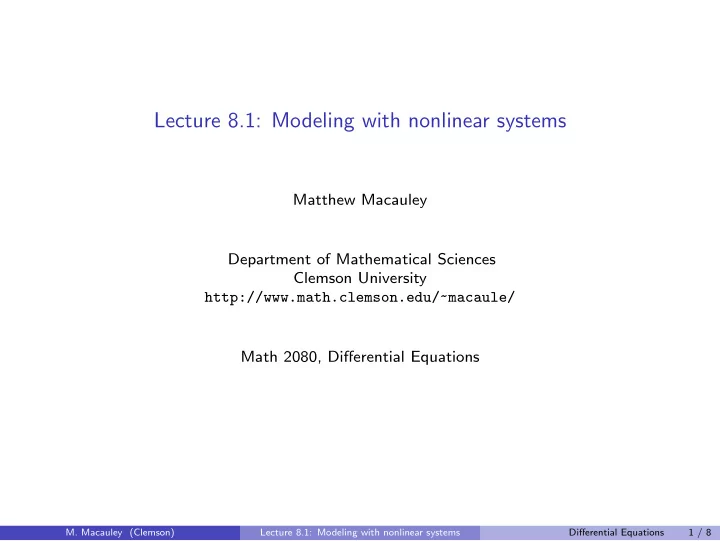

Lecture 8.1: Modeling with nonlinear systems Matthew Macauley Department of Mathematical Sciences Clemson University http://www.math.clemson.edu/~macaule/ Math 2080, Differential Equations M. Macauley (Clemson) Lecture 8.1: Modeling with nonlinear systems Differential Equations 1 / 8
Epidemiology The SIR model Consider an epidemic that spreads through a population, where S ( t ) = # susceptible people at time t ; I ( t ) = # infected people at time t ; R ( t ) = # recovered people at time t . Initially, there are N susceptible (uninfected) people. M. Macauley (Clemson) Lecture 8.1: Modeling with nonlinear systems Differential Equations 2 / 8
Other epidemic models SI model (e.g., herpes, HIV). � S ′ = − α SI α S I I ′ = α SI SIS model. Disease w/o immunity (e.g., chlamydia). α � S ′ = − α SI + γ I S I I ′ = α SI − γ I γ SIRS model. Finite-time immunity (e.g., common cold). S ′ = − α SI + δ R γ α I ′ = α SI − γ I S I R R ′ = γ I − δ R δ M. Macauley (Clemson) Lecture 8.1: Modeling with nonlinear systems Differential Equations 3 / 8
Other epidemic models SEIR model. E = exposed (incubation period, no symptoms). S ′ = − α SI E ′ = α SI − ǫ E γ α ǫ S E I R I ′ = ǫ E − γ I R ′ = γ I SIR model with birth and death rate. β S ′ = − α SI + β S − µ S γ α I ′ = α SI − γ I − µ I S I R R ′ = γ I − µ R µ µ µ M. Macauley (Clemson) Lecture 8.1: Modeling with nonlinear systems Differential Equations 4 / 8
Population dynamics: competing species Competitive Lotka–Volterra equations Consider two species competing for a limited food supply. X ( t ) = population of Species 1; Y ( t ) = population of Species 2. Assume that each species, without the other, would grow logistically. M. Macauley (Clemson) Lecture 8.1: Modeling with nonlinear systems Differential Equations 5 / 8
Population dynamics: predator–prey Classical Lotka–Volterra equations Consider two species, one of which depends on the other as a food source: X ( t ) = population of the prey. Y ( t ) = population of the predator. Assume that in the absense of the other species: the prey would grow exponentially; the predator would decay exponentially. M. Macauley (Clemson) Lecture 8.1: Modeling with nonlinear systems Differential Equations 6 / 8
Population dynamics: predator–prey Modified Lotka–Volterra equations Consider two species, one of which depends on the other as a food source: X ( t ) = population of the prey. Y ( t ) = population of the predator. Assume that in the absense of the other species: the prey would grow logistically; the predator would decay exponentially. M. Macauley (Clemson) Lecture 8.1: Modeling with nonlinear systems Differential Equations 7 / 8
Other population models Immune system vs. infective agent Let X ( t ) = population of immune cells, Y ( t ) = level of infection: � X ′ = rY − sXY Y ′ = uY − vXY − sXY : negative effect on immune system from fighting − vXY : limited effect of immune system in fighting rY : immune response is proportionate to infection level Mutualism Let X ( t ) = population of sharks, Y ( t ) = population of feeder fish: � X ′ = rX (1 − X / M ) + sXY Y ′ = − uY + vXY M. Macauley (Clemson) Lecture 8.1: Modeling with nonlinear systems Differential Equations 8 / 8
Recommend
More recommend